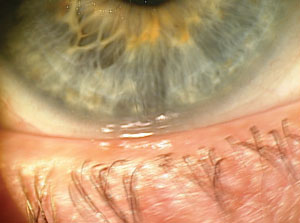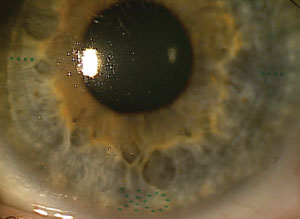 |  |
Solution sensitivity
Individuals wearing a frequent replacement lens not approved for extended wear require multipurpose disinfecting solutions to care for their lenses. Some individuals may experience solution sensitivities over time.1,2,3 Removing care solutions by prescribing daily disposable lenses will often alleviate the signs and symptoms associated with solution sensitivity.
Compliance issues
Research demonstrates a clear link between noncompliance with manufacturers’ recommended replacement frequency (a common problem with frequent replacement lens wearers) and a degradation in contact lens comfort levels.4,5
In addition, studies show most individuals do not clean and replace their storage solution appropriately.6-8 Daily disposables help avoid these challenges, as cleaning and storage are not required.9 Further, at least one study shows daily disposable lens wearers are the most compliant of all lens wearers.10
 |
| Fig. 1. Small mark located at the six o’clock position as seen in most lenses for astigmatism. |
Medical history
Certain medical conditions such as seasonal allergic conjunctivitis warrant consideration for daily disposable lens wear.11 After treating the underlying condition, daily disposable lenses are a beneficial option, considering allergens and other immune complexes commonly seen in the tears of allergy sufferers will be disposed of at the end of the day.12,13
Giant papillary conjunctivitis (GPC), in particular, is a much more chronic form of allergy that usually requires more aggressive medical therapy. GPC is typically caused by excessive deposition on contact lens surfaces, causing an immunological response of the conjunctival tissue and leading to “giant papillae.”14,15 These cases often warrant temporary discontinuation of contact lenses and topical corticosteroid therapy.16 Although lens wear can continue after the response is controlled, the cleanest surface will ultimately provide the best patient outcomes and the least likelihood of recurrence.
With so many advantages to daily disposable lens wear, it is no wonder that we are more frequently reaching for this modality with our contact lens wearers. Limited parameter availability has traditionally hindered our ability to fit a number of our contact lens wearers for daily disposable lenses. But, in the last several years, contact lens manufacturers have introduced a variety of technologies that allow our patients to have an enhanced daily disposable lens wearing experience through new materials and the availability of multifocal and toric contact lens options.
The availability of toric contact lens options in a daily disposable modality is critical when fitting the contact lens neophyte, including pediatric patients. One study disproved the preconceived notion that patients younger than 13 cannot wear contact lenses.17 The advent of daily disposable astigmatic designs offers more individuals the comfort and convenience our spherical lens wearers currently enjoy.
Astigmatism
Healthy ocular findings, high motivation and maturity are the markers of a good pediatric candidate for astigmatic correction though contact lenses. These daily disposable astigmatism correcting contact lenses are well suited for any individuals requiring astigmatic correction, especially children:
• 1-Day Acuvue Moist for Astigmatism (Johnson & Johnson Vision Care)
This lens material is the same technology in the 1-Day Acuvue Moist spherical lens: etafilcon A and 58% water.18 It provides stability through a blink stabilized design based on a dual thin zone, along with additional stabilization factors that interact with both the upper and lower lid. The orientation markers are located at the six and 12 o’clock position (Figure 1). Notably, there is no fear of placing this lens upside down on the eye; either orientation will feel identical to the patient and provide the same visual experience.
 |
| Fig. 2. ‘OK’ marking along with three and nine o’clock markings with the Dailies AquaComfort Plus Toric Lens. |
• Biotrue OneDay for Astigmatism (Bausch + Lomb)
This lens is made of the same material as its spherical predecessor, the Biotrue OneDay lens: nesofilcon A and 78% water content. It contains polyvinylpyrrolidone (PVP) that facilitates the high water content and poloxamer 407, which helps retain moisture and prevent dehydration on the lens. The lens is stabilized on the eye with a peri-ballast design and has a light blue visibility tint. The orientation marker on this lens is located at the six o’clock position and is easily seen at the slit lamp. A fine laser-etched mark indicates the axis of the lens.19
• Clariti 1 Day Toric (Cooper Vision)
This lens is a silicone hydrogel daily disposable made of somofilcon A and is 56% water. The material is the same as that in the Clariti 1 Day sphere and multifocal lens.20 The modulus of the lens is relatively low for a silicone hydrogel lens, which makes it feel similar to a hydrogel when handling the it. The stability of the lens is created through a prism ballast design in addition to a back surface toric profile. The orientation marker is located at the six o’clock position, making it easily visible at the slit lamp.
• Dailies AquaComfort Plus Toric (Alcon)
This lens is made of nelfilcon A and is 69% water, the same as the Dailies AquaComfort Plus sphere and multifocal lenses. This lens contains hydroxypropyl methylcellulose, which aids in initial comfort. Additionally, moisturizing agents polyvinyl alcohol and polyethylene glycol are released from the lens throughout the day.21 The lens is stabilized through a dual thin zone along with a back surface toric design with scribe marks located at the three and nine o’clock positions. There is also an “OK” inversion indicator on the lens (Figure 2). The back of the “K,” located 90 degrees from the horizontal meridian, can be used as an indicator of rotation.
With the growing number of daily disposable toric lens options, we can provide more patients than ever with the benefits they bring, especially for new contact lens wearers and children. Make use of these ever-improving options when appropriate to offer your pediatric patients the benefits of a daily disposable lens.
1. Kalsow CM, Reindel WT, Merchea MM, et al. Tear cytokine response to multipurpose solutions for contact lenses. Clin Ophthalmol. 2013;(7):1291-302.
2. Choy CK, Cho P, Boost MV. Cytotoxicity and effects on metabolism of contact lens care solutions on human corneal epithelium cells. Clin Exp Optom. 2012 Mar;95(2):198-206.
3. Epstein AB. Contact lens care products effect on corneal sensitivity and patient comfort. Eye Contact Lens. 2006 May;32(3):128-32.
4. Ramamoorthy P, Nichols JJ. Compliance factors associated with contact lens-related dry eye. Eye Contact Lens. 2014 Jan;40(1):17-22.
5. Dumbleton K, Woods C, Jones L, et al. Comfort and vision with silicone hydrogel lenses: effect of compliance. Optom Vis Sci. 2010 Jun;87(6):421-5.
6. Robertson DM, Cavanagh HD. Non-compliance with contact lens wear and care practices: a comparative analysis. Optom Vis Sci. 2011 Dec;88(12):1402-8.
7. Dumbleton KA, Spafford MM, Sivak A, Jones LW. Exploring compliance: a mixed-methods study of contact lens wearer perspectives. Optom Vis Sci. 2013 Aug;90(8):898-908.
8. Morgan PB, Efron N, Toshida H, Nichols JJ. An international analysis of contact lens compliance. Cont Lens Anterior Eye. 2011 Oct;34(5):223-8.
9. Dumbleton K, Richter D, Bergenske P, Jones LW. Compliance with lens replacement and the interval between eye examinations. Optom Vis Sci. 2013 Apr;90(4):351-8.
10. Dumbleton K, Richter D, Woods C, et al. Compliance with contact lens replacement in Canada and the United States. Optom Vis Sci. 2010 Feb;87(2):131-9.
11. Siddique M, Manzouri B, Flynn TH, Ono SJ. Allergy and contact lenses. Chem Immunol Allergy. 2007;92:166-75.
12. Nichols KK, Morris S, Gaddie IB, Evans D. Epinastine 0.05% ophthalmic solution in contact lens-wearing subjects with a history of allergic conjunctivitis. Eye Contact Lens. 2009 Jan;35(1):26-31.
13. Brodsky M, Berger WE, Butrus S, et al. Evaluation of comfort using olopatadine hydrochloride 0.1% ophthalmic solution in the treatment of allergic conjunctivitis in contact lens wearers compared to placebo using the conjunctival allergen-challenge model. Eye Contact Lens. 2003 Apr;29(2):113-6.
14. Solomon A. Allergic manifestations of contact lens wearing. Curr Opin Allergy Clin Immunol. 2016 Oct;16(5):492-7.
15. Elhers WH, Donshik PC. Giant papillary conjunctivitis. Curr Opin Allergy Clin Immunol. 2008 Oct;8(5):445-9.
16. Bartlett JD, Howes JF, Ghormley NR, et al. Safety and efficacy of loteprednol etabonate for treatment of papillae in contact lens-associated giant papillary conjunctivitis. Curr Eye Res. 1993 Apr;12(4):313-21.
17. Walline JJ, Jones LA, Rah MJ, et al. Contact Lenses in Pediatrics (CLIP) Study: chair time and ocular health. Optom Vis Sci. 2007 Sep;84(9):896-902.
18. Acuvue. Available at www.acuvueprofessional.com/product/moist-astigmatism. Accessed January 4, 2017.
19. Bausch + Lomb. BioTrue oneday for astigmatism. Available at www.bausch.com/our-products/contact-lenses/lenses-for-astigmatism/biotrue-oneday-for-astigmatism. Accessed January 4, 2017.
20. Cooper Vision. Clariti 1 day toric. Available at http://coopervision.com/contact-lenses/clariti-1-day-toric. Accessed January 4, 2017.
21. Alcon. Dailies aquacomfort plus contact lenses. Available at www.myalcon.com/products/contact-lenses/dailies/aquacomfort-plus-technology.shtml. Accessed January 6, 2017.


